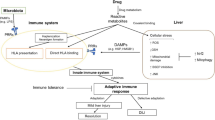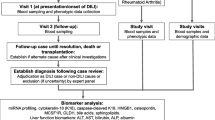Abstract
Background: Drug-induced liver injury (DILI) is an uncommon adverse drug reaction of increasing importance to the medical community, pharmaceutical industry, regulatory agencies and the general public.
Objectives: The Drug-Induced Liver Injury Network (DILIN) was established to advance understanding and research into DILI by initiating a prospective registry of patients with bona fide DILI for future studies of host clinical, genetic, environmental and immunological risk factors. The DILIN was also charged with developing standardized nomenclature, terminology and causality assessment instruments.
Methods: Five clinical sites, a data coordinating centre and senior scientists from the National Institute of Diabetes and Digestive and Kidney Diseases initiated the DILIN prospective study in September 2004. Eligible patients are required to meet minimal laboratory or histological criteria within 6 months of DILI onset and have other competing causes of liver injury excluded. Patients in the general community setting with pre-existing HIV, hepatitis B virus or hepatitis C virus infections and/or abnormal baseline liver biochemistries are eligible for enrolment. In addition, subjects with liver injury due to herbal products are eligible to participate. Control patients without DILI are also to be recruited in the future.
Results: All referred subjects undergo an extensive review of available laboratory, pathology and imaging studies. Subjects who meet pre-defined eligibility criteria at the 6-month study visit are followed for 2 years to better define the natural history of chronic DILI. Causality assessment is determined by a panel of three hepatologists who independently assign a causality score ranging from 1 (definite) to 5 (unlikely) as well as a severity score ranging from 1 (mild) to 5 (fatal). During the first 3 years, 367 subjects were enrolled into the DILIN prospective study. Conclusion: DILIN is a multicentre research network charged with improving our understanding of the aetiologies, risk factors and outcomes of DILI in the US. The network is meeting the targeted enrolment of ten patients per month and is developing a repository of clinical data and biological samples for future studies of DILI pathogenesis and outcome.







Similar content being viewed by others
References
Ostapowicz G, Fontana RJ, Schiodt RV, et al. Results of a prospective study of acute liver failure at 17 tertiary care centers in the United States. Ann Intern Med 2002; 137: 947–54
Lee WM, Senior JR. Recognizing drug-induced liver injury: current problems, possible solutions. Toxciol Pathol 2005; 33: 155–64
Favreau JT, Ryu ML, Braunstein G, et al. Severe hepatoxicity associated with the dietary supplement Lipokinetix. Ann Intern Med 2002; 136: 590–5
Stickel F, Baumuller HM, Seitz K, et al. Hepatitis induced by Kava (Piper methysticum rhizome). J Hepatol 2003; 39: 62–7
Bjornson E, Olsson R. Outcome and prognostic markers in severe drug-induced liver disease. Hepatology 2005; 42: 481–9
Watkins PB, Seeff LB. Drug induced liver injury: summary of a single topic clinical research conference. Hepatology 2006; 43: 618–31
Walgren JL, Mitchell MD, Thompson DC. Role of metabolism in drug-induced idiosyncratic hepatotoxicity. Crit Rev Toxicol 2005; 35: 325–61
Navarro VJ, Senior JR. Drug related hepatotoxicity. N Engl J Med 2006; 354: 731–9
Andrade RJ, Lucena I, Alonso A, et al. HLA class II genotype influences the type of liver injury in drug-induced idiosyncratic liver disease. Hepatology 2004; 39: 1603–12
Kaplowitz N. Causality assessment versus guilt-by-association in drug hepatotoxicity. Hepatology 2001; 33: 308–10
Verma A, Lilienfeld DE. The need for a population-based surveillance system for liver disease in the United States. Pharmacoepidemiol Drug Saf 2004; 13: 821–4
Hoofnagle JH. Drug induced liver injury network (DILIN). Hepatology 2004; 40: 773
Ware JE, Sherbourne CD. The MOS 36-item short-form health survey (SF-36): I. Conceptual framework and item selection. Med Care 1992; 30: 473–83
Varni JW, Burwinkle TM, Seid M, et al. The PedsQL 4.0 as a pediatric population health measure: feasibility, reliability, and validity. Ambul Pediatr 2003; 3: 329–41
Nunez M, Soriano V. Hepatotoxicity of antiretrovirals: incidence, mechanisms, and management. Drug Saf 2005; 38: 53–66
Ogedegbe AO, Sulkowski MS. Antiretroviral-associated liver injury. Clin Liver Dis 2003; 7: 475–99
Ioannou GN, Boyko EJ, Lee SP. The prevalence and predictors of elevated serum aminotransferase activity in the United States in 1999–2002. Am J Gastroenterol 2006; 101: 76–82
Aithal PG, Day CP. The natural history of histologically proved drug induced liver disease. Gut 1999; 44: 731–5
Kleiner DA, Chalasani NP, Conjeevaram HS, et al. Relationship of biochemical to histologic findings and the pathological pattern of injury among cases identified in the NIH drug induced liver injury network (DILIN) study [abstract]. Gastroenterology 2007; 132: M1775
Andrade RJ, Lucerna MI, Fernandez MC, et al. Drug-induced liver injury: an analysis of 461 incidences submitted to the Spanish registry over a 10-year period. Gastroenterology 2005; 129: 512–21
Shapiro MZ, Lewis JH. Causality assessment of drug-induced hepatotoxicity: promises and pitfalls. Clin Liver Dis 2007; 11: 477–505
Danan G, Benichou C. Causality assessment of adverse reactions to drugs: a novel method based on the conclusions of international consensus meetings: application to drug-induced liver injuries. J Clin Epidemiol 1993; 46: 1323–30
Chalasani N, Fontana RJ, Bonkovsky HL, for the Drug Induced Liver Injury Network (DILIN). Causes, clinical features, and outcomes from a prospective study of drug induced liver injury in the United States. Gastroenterology. Epub 2008 Sep 17
Hunter DJ, Kraft P. Drinking from the fire hose: statistical issues in genome-wide association studies. N Engl J Med 2007; 357: 436–9
Ballet F. Hepatotoxicity in drug development: detection, significance and solutions. J Hepatol 1997; 26 Suppl. 2: 26–36
Fontana RJ, McCashland TM, Benner KG, et al. Acute liver failure associated with prolonged use of bromfenac 68 leading to liver transplantation. Liver Transpl Surg 1999; 5: 480–4
Graham DJ, Green L, Senior JR, et al. Troglitazone-induced liver failure: a case study. Am J Med 2003; 114: 299–306
Lee WM, Larrey D, Olsson R, et al. Hepatic findings in long-term clinical trials of ximelagatran. Drug Saf 2005; 28: 351–70
Wysowski DK, Swartz L. Adverse drug event surveillance and drug withdrawals in the United States, 1969–2002. Arch Intern Med 2005; 165: 1363–9
Devalle MB, Klinteberg AV, Alem N, et al. Drug induced liver injury in a Swedish University hospital outpatient hepatology clinic. Aliment Pharmacol Ther 2006; 24: 1187–95
Galan M, Potts J, Silverman AL, et al. The burden of acute non-fulminant drug-induced hepatitis in a United States Tertiary care center. J Clin Gastroenterol 2005; 39: 64–7
Sgro C, Clinard F, Ouazir K, et al. Incidence of drug-induced hepatic injuries: a French population-based study. Hepatology 2002; 36: 451–5
Whitehead MW, Hainsworth I, Kingham JGC. The cause of obvious jaundice in South West Wales: perceptions versus reality. Gut 2001; 48: 409–13
Ibanez L, Perez E, Vidal X, et al. Prospective surveillance of acute serious liver disease unrelated to infectious obstructive or metabolic diseases: epidemiological and clinical features, and exposure to drugs. J Hepatology 2002; 37: 592–600
Rumack BH. Acetaminophen hepatotoxicity: the first 35 years. J Toxicol Clin Toxicol 2002; 40: 3–20
LaRusso NF, Schneider BL, Black D, et al. Primary sclerosing cholangitis: summary of a workshop. Hepatology 2006; 44: 746–64
Patel PA, Voigt MD. Prevalence and interaction of hepatitis B and latent tuberculosis in Vietnamese immigrants to the United States. Am J Gastroenterol 2002; 97: 1198–203
Mok MY, Ng WL, Yuen MF, et al. Safety of disease modifying anti-rheumatic agents in rheumatoid arthritis patients with chronic viral hepatitis. Clin Exp Rheumatol 2000; 18: 363–8
Benichou C. Criteria of drug-induced liver disorders: report of an international consensus meeting. J Hepatol 1990; 11: 272–6
Andrade RJ, Lucena MI, Kaplowitz N, et al. Outcome of acute idiosyncratic drug-induced liver injury: long-term follow-up in a hepatotoxicity registry. Hepatology 2006; 44: 1581–8
Lok ASF, McMahon B. AASLD practice guideline: chronic hepatitis B. Hepatology 2007; 45: 507–39
Dienstag JL, McHutchison JG. American Gastroenterological Association technical review on the management of hepatitis C. Gastroenterology 2006; 130: 231–64
Sharp JR, Ishak KG, Zimmerman HJ. Chronic active hepatitis and severe hepatic necrosis associated with nitrofurantoin. Ann Intern Med 1980; 92: 14–9
Shergy WJ, Polisson RP, Caldwell DS, et al. Methotrexate-associated hepatotoxicity: retrospective analysis of 210 patients with rheumatoid arthritis. Am J Med 1988; 85: 771–4
Rockey DC, Seeff LB, Freston JW, et al. Comparison between expert opinion and RUCAM for assignment of causality in drug induced liver injury [abstract]. Gastroenterology 2007; 132: M1777
Rochon J, Protiva B, Seeff LB, the Drug Induced Liver Injury Network. The reliability of the RUCAM for assessing causality in drug-induced liver injury. Hepatology 2008; 48: 1175–83
Krivoy N, Taeri M, Neuman MG. Antiepileptic drug-induced hypersensitivity syndrome reactions. CNS Drugs 2004; 18: 5–25
Acknowledgements
Funding for the DILIN is provided by the NIDDK under cooperative agreements: 1U01DK065201, 1U01DK065193, 1U01DK065184, 1U01DK065211, 1U01DK065238 and 1U01DK065176.
The authors have the following disclosures: Robert J. Fontana: Speaker’s Bureau for Roche Laboratories, Bristol-Meyers Squibb, consultant for Vertex Pharmaceuticals; Naga Chalasani: consultant for or grant funding from Takeda, Atherogenics, Eli-Lilly Company, Merck, Abbott, Ortho-McNeill, Metabasis Advanced Life Sciences, Sanof-Aventis, Deviousion; Herbert L. Bonkovsky: served as a paid advisor to Infracare, Novartis and Ovation Pharmaceuticals and is on the Speaker’s Bureau for Ovation Pharmaceuticals, grant support from Merck, Novartis, Roche and Vertex, during the past 12 months he served as an expert witness for plaintiffs in litigation regarding potential DILI; Paul B. Watkins: served as a paid consultant in the preceding 12 months to the following pharmaceutical companies: Actellion, Aldus, Astellas, Bristol-Myers Squibb, Boerringer-Ingleheim, Danube, Endo, Fibrogen, GlaxoSmithKline, Hoffman-LaRoche, Imtech, King, Mellenium, Merck, Novartis, Nuon, Orion, Pfizer, Pharmasset, Schering Plough, TAP, Valiant, VIA and Wyeth, he served as both a plaintiff and defence expert in litigation involving suspected DILI involving some of these companies. Drs Rochon, Davern and Serrano have no financial disclosures relating to this work.
The following is a list of the principal investigators (co-investigators) and [study coordinators] participating in the DILIN: University of North Carolina at Chapel Hill: Paul Watkins, Chair of DILIN Steering Committee (Paul Hayashi, Mark Russo) [Anne Criss, Susan Pusek, Gale Groseclose]; University of Connecticut Health Center: Herbert Bonkovsky (James Freston, Robert Levine, Benedict Maliakkal, Petr Protiva, Robert Rosson) [Jane Bulger, Mariola Smialek, Paul Appleton]; Indiana University School of Medicine: Naga Chalasani (Lawrence Lumeng, Raj Vuppalanchi) [Audrey Corne]; University of California San Francisco: Tim Davern (Maurizio Bonacini) [Dalia Moawad, Kristine Partovi]; University of Michigan: Robert Fontana (Hari Conjeeveram) [Suzanne Welch, Jordan Kridler]; Data Coordinating Center, Duke Clinical Research Institute: James Rochon (John McHutchison, Don C. Rockey) [Carla Ange, Katherine Berezny, Michelle Crowder, Satarah Latiker, Mary Moggio, Lauren Ruffrage, Carmel Scharenbroich, June Wampole]; NIDDK: José Serrano, Leonard Seeff, Jay Hoofnagle; NIDDK Biosample Repository: David Toke (Dana Witt), Rutgers University; Rich Frome, Fisher BioServices; Liver Histopathology Review Center: David Kleiner, National Cancer Institute.
Author information
Authors and Affiliations
Consortia
Corresponding author
Rights and permissions
About this article
Cite this article
Fontana, R.J., Watkins, P.B., Bonkovsky, H.L. et al. Drug-Induced Liver Injury Network (DILIN) Prospective Study. Drug-Safety 32, 55–68 (2009). https://doi.org/10.2165/00002018-200932010-00005
Published:
Issue Date:
DOI: https://doi.org/10.2165/00002018-200932010-00005




